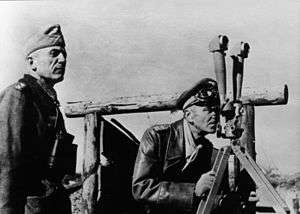Walther von Seydlitz-Kurzbach
| Walther von Seydlitz-Kurzbach | |
|---|---|
 Seydlitz-Kurzbach (left) and Friedrich Paulus in Soviet Union, 1942 | |
| Born |
22 August 1888 Eppendorf, Hamburg, German Empire |
| Died |
28 April 1976 (aged 87) Bremen, West Germany |
| Allegiance |
|
| Service/ | Army |
| Years of service | 1908–43 |
| Rank | General of the Artillery |
| Commands held |
112th Infantry Division LI Corps |
| Battles/wars |
|
| Awards | Knight’s Cross with Oak Leaves |
Walther Kurt von Seydlitz-Kurzbach (22 August 1888 – 28 April 1976) was a general in the German Wehrmacht during World War II and a recipient of the Knight's Cross of the Iron Cross with Oak Leaves. Seydlitz-Kurzbach was relieved of his command in early 1943 and then abandoned the German army lines under German fire to surrender to the Red Army. He became a Soviet collaborator while a prisoner of war. After the war he was convicted by the Soviet Union of war crimes. In 1996 he was posthumously pardoned by Russia.
Career
Seydlitz-Kurzbach was born in Hamburg, Germany, into the noble Prussian Seydlitz family. During World War I he served on both fronts as an officer. During the Weimar Republic he remained a professional officer in the Reichswehr; from 1940-42 he commanded the 12th Infantry Division of the German Army. When the division was encircled in the Demyansk Pocket, Seydlitz was responsible for breaking the Soviet cordon and enabling German units to escape from encirclement; for this action he was promoted to General of the Artillery and appointed commander of the LI Corps.
The corps was subordinated to the Sixth Army during the Battle of Stalingrad.[1] When the entire army was trapped in the city in the course of the Soviet Operation Uranus, Seydlitz was one of the generals who argued most forcefully in favor of a breakout or a surrender, in contravention of Hitler’s orders.[1]:126–127,132–133 On 25 January 1943 he told his subordinate officers that they were free to decide for themselves on whether to surrender. Paulus immediately relieved him of command of his three divisions (the 100th, 71st and 295th Infantry Divisions).[1]:199[2]
A few days later Seydlitz fled the German lines under fire from his own side with a group of other officers.[3] He was taken into Soviet custody, where he was interrogated by Capt. Nikolay Dyatlenko.[4] He was identified by the interrogations as a potential collaborator. In August 1943 he was taken with two other generals to a political re-education center at Lunovo.[5] A month later he was sent back to prisoner of war camps to recruit other German officers.
Seydlitz was a leader in the forming, under Soviet supervision, of an anti-Nazi organization, the League of German Officers, and was made a member of the National Committee for a Free Germany. He was condemned by many of his fellow generals for his collaboration with the Soviet Union. He was sentenced to death in absentia by Hitler's government. His idea of creating an anti-Nazi force of some 40,000 German POWs to be airlifted into Germany was never seriously considered, while in Germany his family was taken into Sippenhaft, detention for the crimes of a family member. Seydlitz was ultimately exploited by both Soviet and German propaganda: he was used by the former in broadcasts and literature to encourage German soldiers to surrender, while the latter cultivated the idea of "Seydlitz troops" (German: Seydlitztruppen). His role in Soviet propaganda was largely equivalent to that of Andrey Vlasov in Nazi propaganda.
In 1949 he was charged with war crimes. He was put on trial for responsibility for actions against Soviet POWs and the civilian population while in Wehrmacht service. In 1950 a Soviet tribunal sentenced him to 25 years’ imprisonment, but in 1955 he was released to West Germany, where in 1956 his Third Reich death sentence was nullified.
Seydlitz died on 28 April 1976 in Bremen. On 23 April 1996 a posthumous pardon was issued by Russian authorities.
Awards
- Iron Cross (1914) 2nd Class (19 September 1914) & 1st Class (21 October 1915)[6]
- Clasp to the Iron Cross (1939) 2nd Class (17 May 1940) & 1st Class (22 May 1940)[6]
- Knight's Cross of the Iron Cross with Oak Leaves
References
Citations
Bibliography
- Beevor, Antony (1998). Stalingrad. Viking, London. ISBN 978-0-14-103240-5.
- Scherzer, Veit (2007). Die Ritterkreuzträger 1939–1945 Die Inhaber des Ritterkreuzes des Eisernen Kreuzes 1939 von Heer, Luftwaffe, Kriegsmarine, Waffen-SS, Volkssturm sowie mit Deutschland verbündeter Streitkräfte nach den Unterlagen des Bundesarchives [The Knight's Cross Bearers 1939–1945 The Holders of the Knight's Cross of the Iron Cross 1939 by Army, Air Force, Navy, Waffen-SS, Volkssturm and Allied Forces with Germany According to the Documents of the Federal Archives] (in German). Jena, Germany: Scherzers Militaer-Verlag. ISBN 978-3-938845-17-2.
- Thomas, Franz (1998). Die Eichenlaubträger 1939–1945 Band 2: L–Z [The Oak Leaves Bearers 1939–1945 Volume 2: L–Z] (in German). Osnabrück, Germany: Biblio-Verlag. ISBN 978-3-7648-2300-9.
External links
- Walther von Seydlitz-Kurzbach in the German National Library catalogue
- Newspaper clippings about Walther von Seydlitz-Kurzbach in the 20th Century Press Archives of the German National Library of Economics (ZBW)
| Military offices | ||
|---|---|---|
| Preceded by Generalleutnant Ludwig von der Leyen |
Commander of 12. Infanterie-Division March 10, 1940 – January 1, 1942 |
Succeeded by Oberst Karl Hernekamp |